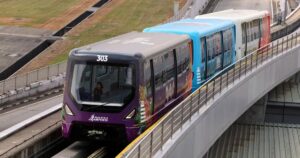
If only Malaysia’s flying car project had taken off. Then Penang state executive councillor Zairil Khir Johari’s vision of flying buses zipping through the George Town airspace would now be a common sight.
We were nearly there in 2019. In November that year, then entrepreneur development minister Redzuan Yusof invited MPs to witness his first flight on what was to be the prototype of Malaysia’s flying car.
He even invited Barisan Nasional’s Paya Besar MP Shahar Abdullah to join him in the two-seater flying machine.
Unfortunately, the flight was cancelled. Perhaps it was the weather.
Had the flying car lifted off that day, flying buses could now be soaring over George Town, ferrying commuters to their offices in the morning rush hour, ensuring they clock in not a minute late.
Traffic jams would then be a thing of the past. Busy thoroughfares such as Beach Street and Penang Road could very well be turned into pedestrian walkways.
But buses have not sprouted wings, so Zairil’s answer to the constant road congestion in Penang is more flyovers.
To justify the Penang government’s plan to build more large-scale infrastructure projects, he told FMT that flyovers and underpasses are essential for proper traffic dispersal.
He even warned that providing for more bus lanes without “proper planning” could worsen the existing situation.
Apart from his disdainful remark that “unless buses could fly, they would be using the same roads”, Zairil has chosen to ignore experts’ views that more roads do not necessarily reduce traffic congestion.
Records have shown that commuters in cities such as Jakarta, Bangkok and Toronto continue to get stuck in traffic jams despite road expansions. Flying buses would have been a more viable option for these urban sprawls.
Economic cost
Traffic congestion has had a major economic impact on Malaysia.
According to a 2020 World Bank estimate, traffic snarls in the Klang Valley alone have resulted in the loss of more than 250 million man-hours per year. That translates into an economic cost of up to RM20 billion annually.
While specific data is not available for Penang, the TomTom Traffic Index, a global network of connected devices with data contributions from up to three vehicles in some cities, singled out George Town as the most congested city in Malaysia.
A study from 2010 shows that traffic jams on Penang Bridge alone led to a total of 328 million hours of travel delay a year.
The Klang Valley is a prime example of how the construction of more infrastructure has failed to ease the jam.
Penang will be the next Klang Valley if it continues to drive down the same road.
Short of deploying buses that fly, perhaps we can learn a thing or two from cities such as Hong Kong and Singapore.
Both are constrained by a limited supply of real estate, making it unrealistic to build more roads. Yet, they have been able to avoid problems faced by Jakarta and Bangkok.
The views expressed are those of the writer and do not reflect those of FMT.






